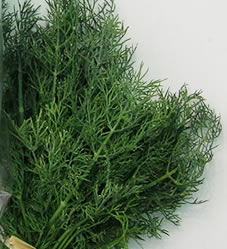Dill
Dill
Absinthe
Basil
Borage
Calamint
Capers
Chervil
Coriander
Tarragon
Chives
Wild fennel
Lavender
Lovage
Lippia Citriodora
Marjoram
Lemon balm
Mint
Myrtle
Oregano
Chilli pepper
Salad burnet
Parsley
Rosemary
Garden rocket
Rue
Sage
Celery
Thyme
Valerian
HISTORICAL HINTS:
The scientific name of this species (Anethum graveolens) comes from the Greek “anethon” which, on its turn, comes from ancient Egyptian. The term may mean “to keep away illness” referring to its medicinal properties. The specific adjective “graveolens” comes from Latin, “gravis” (strong) and “olens” (smell) because it has a very strong smell. The accepted scientific binomial name was proposed by Carl Von Linné (1707-1778), Sweden biologist and writer, considered to be the inventor of the modern scientific taxonomy of living organisms, published in “Species Plantarum” in 1753. The English name dill comes from Old English dile, thought to have originated from a Norse or Anglo-Saxon word dylle meaning to soothe or lull.
THE PLANT -
Dill (Anethum Graveolens) is a perennial aromatic herb belonging to the Umbrelliferone family, with its origins in Middle East (India, Persia) and with a fennel and aniseed-like smell. Both seeds and leaves can be used; leaves have a green-bluish colour and are formed by different small filiform, regularly ordered leaves. Its essential oil has got aromatic, refreshing, digestive, antiseptic characteristics. At the end of summer umbrellas are cut and left to dry in shade; later on, they are hit until seeds are expelled. Seeds are canned aside and sealed hermetically.
PROPERTIES –
Dill has light beneficial properties on the stomach: digestive, aperitive, carminative (promotes intestinal gas expulsion), antispasmodic (attenuates muscular spasms and relaxes nervous system), diuretic and anti-inflammatory (attenuates inflammatory states), calming and preparatory for the sleep.
In specific:
- Dill infusion promotes digestion and relieve colitis;
- Seeds infusion allows to stop sobbing, headache and child coughing;
- Other uses: treats indigestion, anxiety nausea, flatulence, intestinal gases, spasms, cramps, helps lactation and it is used as antiseptic too.
Storicamente, fu anche utilizzato per l'epilessia e per favorire l’allattamento delle bambinaie (antichi greci), per calmare gli ospiti di banchetti che avevano bevuto troppo. Carlo Magno, per le sue virtù afrodisiache e contro la mala sorte, (streghe e maghi del medioevo, per aumentare le capacità cerebrali XVII secolo, per "mantenere il calore e l’energia del corpo e donare un’intensa vitalità" e anche per "aumentare il potere d’attrazione nei confronti del sesso opposto" XVII secolo.
Un infuso delle foglie serve anche contro la nausea.
Gli antichi gladiatori pensavano che l'aneto accrescesse la loro forza e per questo condivano ogni loro pasto con i suoi semi, inoltre si coronavano il capo con questa pianta come simbolo di gioia.
Pestando i suoi semi e ponendoli in infusione si ottiene un liquido utile a molti scopi:
- Per fare bagni rinforzanti alle unghie;
- Per favorire la digestione;
- Per placare il singhiozzo e i crampi dello stomaco;
- Per alleviare le flatulenze e l’insonnia.
Inoltre i semi d’aneto vengono masticati per rinfrescare l'alito.
USO IN CUCINA –
Dell'aneto in cucina si usano sia i semi sia le foglie soprattutto nella cucina scandinava, che li accosta ad uova, pesce (salmone), molluschi e patate.
Nella cucina italiana viene adoperato nelle insalate, sulle patate lessate, nelle marinate, nella salsa per i pesci, per insaporire minestre e intingoli e sulla carne alla griglia, ma si accompagna anche a yogurt, panna acida e formaggi freschi.
I semi, molto profumati, sono ideali per aromatizzare l’aceto, e quindi le conserve.























